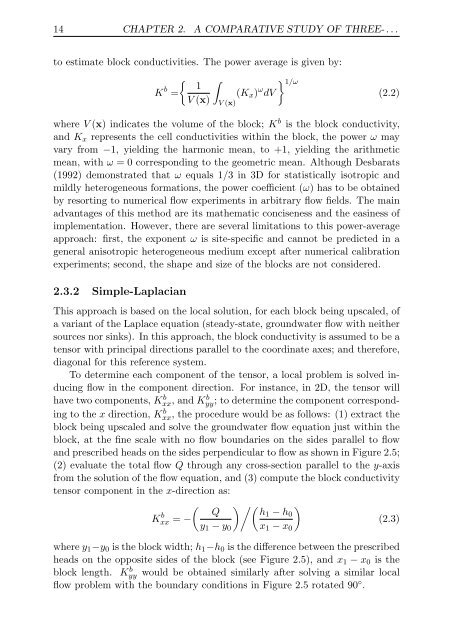Upscaling and Inverse Modeling of Groundwater Flow and Mass ...
Upscaling and Inverse Modeling of Groundwater Flow and Mass ...
Upscaling and Inverse Modeling of Groundwater Flow and Mass ...
Create successful ePaper yourself
Turn your PDF publications into a flip-book with our unique Google optimized e-Paper software.
14 CHAPTER 2. A COMPARATIVE STUDY OF THREE- . . .<br />
to estimate block conductivities. The power average is given by:<br />
K b { ∫<br />
1<br />
=<br />
(Kx)<br />
V (x) V (x)<br />
ω } 1/ω<br />
dV<br />
(2.2)<br />
where V (x) indicates the volume <strong>of</strong> the block; K b is the block conductivity,<br />
<strong>and</strong> Kx represents the cell conductivities within the block, the power ω may<br />
vary from −1, yielding the harmonic mean, to +1, yielding the arithmetic<br />
mean, with ω = 0 corresponding to the geometric mean. Although Desbarats<br />
(1992) demonstrated that ω equals 1/3 in 3D for statistically isotropic <strong>and</strong><br />
mildly heterogeneous formations, the power coefficient (ω) has to be obtained<br />
by resorting to numerical flow experiments in arbitrary flow fields. The main<br />
advantages <strong>of</strong> this method are its mathematic conciseness <strong>and</strong> the easiness <strong>of</strong><br />
implementation. However, there are several limitations to this power-average<br />
approach: first, the exponent ω is site-specific <strong>and</strong> cannot be predicted in a<br />
general anisotropic heterogeneous medium except after numerical calibration<br />
experiments; second, the shape <strong>and</strong> size <strong>of</strong> the blocks are not considered.<br />
2.3.2 Simple-Laplacian<br />
This approach is based on the local solution, for each block being upscaled, <strong>of</strong><br />
a variant <strong>of</strong> the Laplace equation (steady-state, groundwater flow with neither<br />
sources nor sinks). In this approach, the block conductivity is assumed to be a<br />
tensor with principal directions parallel to the coordinate axes; <strong>and</strong> therefore,<br />
diagonal for this reference system.<br />
To determine each component <strong>of</strong> the tensor, a local problem is solved inducing<br />
flow in the component direction. For instance, in 2D, the tensor will<br />
have two components, K b xx, <strong>and</strong> K b yy; to determine the component corresponding<br />
to the x direction, K b xx, the procedure would be as follows: (1) extract the<br />
block being upscaled <strong>and</strong> solve the groundwater flow equation just within the<br />
block, at the fine scale with no flow boundaries on the sides parallel to flow<br />
<strong>and</strong> prescribed heads on the sides perpendicular to flow as shown in Figure 2.5;<br />
(2) evaluate the total flow Q through any cross-section parallel to the y-axis<br />
from the solution <strong>of</strong> the flow equation, <strong>and</strong> (3) compute the block conductivity<br />
tensor component in the x-direction as:<br />
(<br />
Q<br />
)/( )<br />
h1 − h0<br />
K b xx = −<br />
y1 − y0<br />
x1 − x0<br />
(2.3)<br />
where y1−y0 is the block width; h1−h0 is the difference between the prescribed<br />
heads on the opposite sides <strong>of</strong> the block (see Figure 2.5), <strong>and</strong> x1 − x0 is the<br />
block length. K b yy would be obtained similarly after solving a similar local<br />
flow problem with the boundary conditions in Figure 2.5 rotated 90 ◦ .


